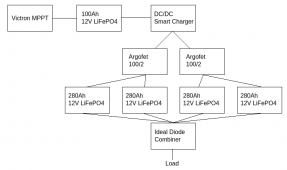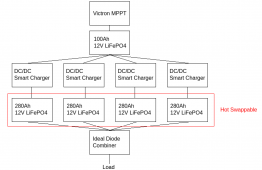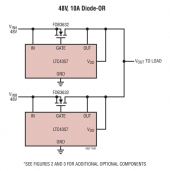jakew009
New Member
- Joined
- Jun 27, 2021
- Messages
- 25
Imagine a system whereby you have 4 x 12v LiFePO4 banks each with their own JBD BMS with common charge / discharge ports.
Each of these batteries needs to be hot swappable individually. As in at any point one of the batteries could be taken out of the pack and recharged from the mains before being reconnected to the base station.
The kicker is that when the 4 hot swap batteries are installed into the base station they also need to be connected to a solar array to recharge them.
Th system is used for powering a 50W load.
How would you approach this?
At the moment I have two thoughts:
a) connect the solar array to a dedicated battery that is never removed. Use 4x DC-DC chargers to charge the hot swappable batteries from the solar battery.
Then use 4 more dc/dc converters to connect the hot swap batteries to the load.
Advantage is that everything is isolated. Disadvantage is that we have wastage from all the DC converters.
b) connect the MPPT directly to the batteries using ideal diodes. Connect the load using ideal diodes.
In this situation the load side would work fine because the highest voltage battery would do all the work until it started to equalise with all the others.
But the bit I am not sure about is the solar charge side. It will be a Victron MPPT if it makes any difference.
Will the solar charge controller get confused? The current will initially flow into the battery with lowest state of charge, until it’s voltage starts to match the others when they will start charging as well.
My concern is the solar charge controller might hold the voltage at 14+ volts whilst the lowest battery is still charging, whilst the other batteries could already be at 100% charge.
Option c) is possibly using DC/DC chargers on the charge side, and ideal diodes on the outputs.
Ideas?
Each of these batteries needs to be hot swappable individually. As in at any point one of the batteries could be taken out of the pack and recharged from the mains before being reconnected to the base station.
The kicker is that when the 4 hot swap batteries are installed into the base station they also need to be connected to a solar array to recharge them.
Th system is used for powering a 50W load.
How would you approach this?
At the moment I have two thoughts:
a) connect the solar array to a dedicated battery that is never removed. Use 4x DC-DC chargers to charge the hot swappable batteries from the solar battery.
Then use 4 more dc/dc converters to connect the hot swap batteries to the load.
Advantage is that everything is isolated. Disadvantage is that we have wastage from all the DC converters.
b) connect the MPPT directly to the batteries using ideal diodes. Connect the load using ideal diodes.
In this situation the load side would work fine because the highest voltage battery would do all the work until it started to equalise with all the others.
But the bit I am not sure about is the solar charge side. It will be a Victron MPPT if it makes any difference.
Will the solar charge controller get confused? The current will initially flow into the battery with lowest state of charge, until it’s voltage starts to match the others when they will start charging as well.
My concern is the solar charge controller might hold the voltage at 14+ volts whilst the lowest battery is still charging, whilst the other batteries could already be at 100% charge.
Option c) is possibly using DC/DC chargers on the charge side, and ideal diodes on the outputs.
Ideas?







